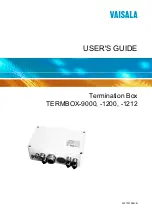
Chapter 8 Basic Setting
GS1920v2 Series User’s Guide
95
The following table describes the labels in this screen.
Table 24 Basic Setting > IPv6 > IPv6 Interface Status
LABEL
DESC RIPTIO N
IPv6 Active
This field displays whether the IPv6 interface is activated or not.
MTU Size
This field displays the Maximum Transmission Unit (MTU) size for IPv6 packets on this interface.
ICMPv6 Rate
Limit Bucket
Size
This field displays the maximum number of ICMPv6 error messages which are allowed to transmit
in a given time interval. If the bucket is full, subsequent error messages are suppressed.
ICMPv6 Rate
Limit Error
Interval
This field displays the time period (in milliseconds) during which ICMPv6 error messages of up to
the bucket size can be transmitted. 0 means no limit.
Stateless
Address
Autoconfig
This field displays whether the Switch’s interface can automatically generate a link-local address
via stateless autoconfiguration.
Link Local
Address
This field displays the Switch’s link-local IP address and prefix generated by the interface. It also
shows whether the IP address is preferred, which means it is a valid address and can be used as a
sender or receiver address.
Global Unicast
Address(es)
This field displays the Switch’s global unicast address to identify this interface.
Joined Group
Address(es)
This field displays the IPv6 multicast addresses of groups the Switch’s interface joins.
ND DAD Active This field displays whether Neighbor Discovery (ND) Duplicate Address Detection (DAD) is
enabled on the interface.
Number of
DAD Attempts
This field displays the number of consecutive neighbor solicitations the Switch sends for this
interface.
NS-Interval
(millisecond)
This field displays the time interval (in milliseconds) at which neighbor solicitations are re-sent for
this interface.
ND Reachable
Time
(millisecond)
This field displays how long (in milliseconds) a neighbor is considered reachable for this interface.
DHCPv6 Client
Active
This field displays whether the Switch acts as a DHCPv6 client to get an IPv6 address from a
DHCPv6 server.
Identity
Association
An Identity Association (IA) is a collection of addresses assigned to a DHCP client, through which
the server and client can manage a set of related IP addresses. Each IA must be associated with
exactly one interface.
IA Type
The IA type is the type of address in the IA. Each IA holds one type of address.
IA_NA
means an
identity association for non-temporary addresses and
IA_TA
is an identity association for
temporary addresses.
IAID
Each IA consists of a unique IAID and associated IP information.
T1
This field displays the DHCPv6 T1 timer. After T1, the Switch sends the DHCPv6 server a Renew
message.
An IA_NA option contains the T1 and T2 fields, but an IA_TA option does not. The DHCPv6 server
uses T1 and T2 to control the time at which the client contacts with the server to extend the
lifetimes on any addresses in the IA_NA before the lifetimes expire.
T2
This field displays the DHCPv6 T2 timer. If the time T2 is reached and the server does not respond,
the Switch sends a Rebind message to any available server.
Содержание GS1920-48HPv2
Страница 19: ...19 PA RT I Use r s Guide...
Страница 43: ...43 PA RT II T e c hnic al Re fe re nc e...
Страница 124: ...Chapter 9 VLAN GS1920v2 Series User s Guide 124 Figure 97 Advanced Application VLAN Port Based VLAN Setup Port Isolation...
Страница 155: ...Chapter 13 Spanning Tree Protocol GS1920v2 Series User s Guide 155 Figure 118 MSTP and Legacy RSTP Network Example...
Страница 193: ...GS1920v2 Series User s Guide 193 Figure 140 Classifier Example...
Страница 224: ...Chapter 24 Multicast GS1920v2 Series User s Guide 224 Figure 162 MVR Group Configuration Example 2 EXAMPLE...
Страница 367: ...Chapter 40 Access Control GS1920v2 Series User s Guide 367 Figure 271 Example Lock Denoting a Secure Connection EXAMPLE...
Страница 388: ...Chapter 48 Configure Clone GS1920v2 Series User s Guide 388 Figure 284 Management Configure Clone...
















































